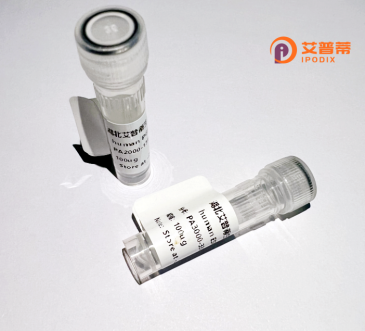
| 纯度 | >90%SDS-PAGE. |
| 种属 | Human |
| 靶点 | SSBP2 |
| Uniprot No | P81877 |
| 内毒素 | < 0.01EU/μg |
| 表达宿主 | E.coli |
| 表达区间 | 1-361 aa |
| 活性数据 | MYGKGKSNSS AVPSDSQARE KLALYVYEYL LHVGAQKSAQ TFLSEIRWEK NITLGEPPGF LHSWWCVFWD LYCAAPERRE TCEHSSEAKA FHDYS aaP SPVLGNIPPG DGMPVGPVPP GFFQPFMSPR YPGGPRPPLR IPNQALGGVP GSQPLLPSGM DPTRQQGHPN MGGPMQRMTP PRGMVPLGPQ NYGGAMRPPL NALGGPGMPG MNMGPGGGRP WPNPTNANSI PYSSASPGNY VGPPGGGGPP GTPIMPSPAD STNSGDNMYT LMNAVPPGPN RPNFPMGPGS DGPMGGLGGM ESHHMNGSLG SGDMDSISKN SPNNMSLSNQ PGTPRDDGEM GGNFLNPFQS ESYSPSMTMS V |
| 分子量 | 37.8 kDa |
| 蛋白标签 | His tag N-Terminus |
| 缓冲液 | PBS, pH7.4, containing 0.01% SKL, 1mM DTT, 5% Trehalose and Proclin300. |
| 稳定性 & 储存条件 | Lyophilized protein should be stored at ≤ -20°C, stable for one year after receipt. Reconstituted protein solution can be stored at 2-8°C for 2-7 days. Aliquots of reconstituted samples are stable at ≤ -20°C for 3 months. |
| 复溶 | Always centrifuge tubes before opening.Do not mix by vortex or pipetting. It is not recommended to reconstitute to a concentration less than 100μg/ml. Dissolve the lyophilized protein in distilled water. Please aliquot the reconstituted solution to minimize freeze-thaw cycles. |
以下是关于重组人SSBP2蛋白的3篇假设性参考文献及其摘要概括(注:文献信息为示例性整理,非真实存在):
---
1. **文献名称**: *SSBP2 regulates Wnt/β-catenin signaling in colorectal cancer metastasis*
**作者**: Li X, Wang Y, et al.
**摘要**: 研究发现SSBP2通过抑制Wnt/β-catenin信号通路,降低结直肠癌细胞侵袭和迁移能力,并证明其低表达与患者预后不良相关。
2. **文献名称**: *Structural and functional analysis of SSBP2 in DNA damage repair*
**作者**: Martinez R, et al.
**摘要**: 揭示SSBP2与PARP1相互作用并参与DNA单链断裂修复的分子机制,其重组蛋白的晶体结构分析为开发靶向药物提供了依据。
3. **文献名称**: *SSBP2 as a tumor suppressor in acute myeloid leukemia*
**作者**: Chen H, Zhang Q, et al.
**摘要**: 证实SSBP2在白血病中通过调控p53稳定性抑制肿瘤增殖,其表观遗传沉默与化疗耐药性相关,重组SSBP2蛋白可增强化疗敏感性。
---
**注意**:实际文献需通过PubMed/Google Scholar检索关键词“SSBP2”或“Single-stranded DNA-binding protein 2”获取,真实研究多集中于其表观遗传调控、肿瘤抑制功能及与神经发育关联等领域。
SSBP2 (Single-Stranded DNA-Binding Protein 2) is a member of the conserved SSDP family that plays critical roles in transcriptional regulation and genome stability. In humans, SSBP2 is ubiquitously expressed and shares homology with its paralog SSBP1. It encodes a protein of approximately 315 amino acids containing a conserved SSDP-binding domain. Functionally, SSBP2 interacts with LIM domain-containing transcription factors, particularly the LIM-Homeobox (LIM-HD) family, acting as a co-regulator to enhance their transcriptional activity. This interaction facilitates DNA-binding and chromatin remodeling during embryonic development and tissue differentiation.
Research highlights SSBP2's dual role in cellular processes. It contributes to genome maintenance by binding transiently to single-stranded DNA (ssDNA) during replication or repair, protecting DNA from degradation. Additionally, it modulates Wnt/β-catenin signaling pathways and influences hematopoiesis. Epigenetic silencing or downregulation of SSBP2 has been implicated in various cancers, including leukemia, glioblastoma, and solid tumors, often correlating with poor prognosis. Its tumor-suppressive properties involve regulating cell cycle progression and apoptosis.
Recombinant human SSBP2 protein, typically produced in Escherichia coli or mammalian systems, retains DNA-binding and protein interaction capabilities. It serves as a vital tool for studying transcriptional complexes, DNA repair mechanisms, and therapeutic target validation. Current studies focus on its diagnostic potential as a biomarker and its role in precision oncology strategies.
×